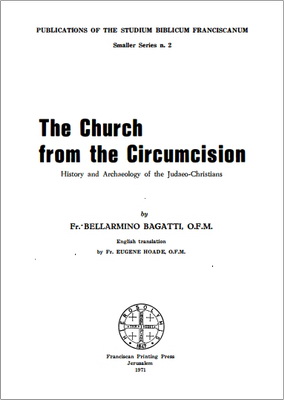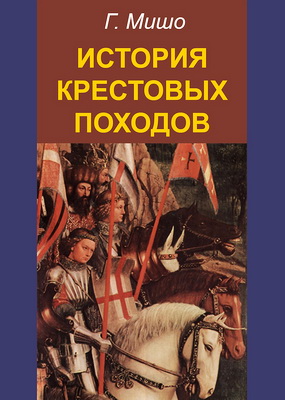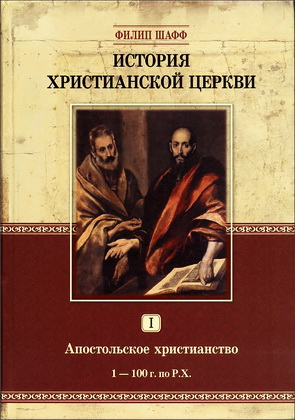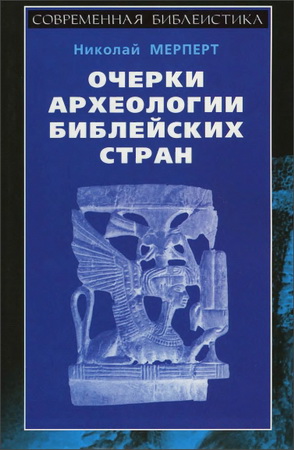
Bagatti - The Church from the Circumcision

In the mosaic of the Church of St. Sabina in Rome, made under Pope Celestine (422-432), at the sides of the great historical inscription there are two female figures, the “Ecclesia ex circumcisione” on the left and the “Ecclesia ex gentibus” on the right. Each has a book in her hand. Over the former is St. Peter, in the act of receiving the law from God’s hand; over the latter is St. Paul. Evidently as a basis of the composition is the saying of St. Paul to the Galatians (2,7): “to me was committed the gospel for the uncircumcised, as to Peter that for the circumcised.” In the mosaic of the Roman church dedicated to Pudentiana, anterior to that of St. Sabina, there is represented in the centre, at the foot of Calvary, Our Lord, at the sides the Apostles, and on either side two women who hold a crow. From these and from other like compositions we can conclude that , in the minds of the mosaicists, the two churches, represented under the female forms, were equal both in teaching and in future recompense.
The archaeology of the church “from the gentiles” has been illustrated in many manuals, some recent and up-to-date; that of the church “from the circumcision,” on the contrary, has remained all but neglected. The scope of the present volume is to summarize the elements which illustrate the ancient history of the church of Jewish stock from the historical and monumental aspects. It has an historical part and an archaeological part with the purpose of giving a complete picture.
What led to the compiling of this study was the need to illustrate the archaeological material found in the excavations of Dominus Flevit on the Mount of Olives, of Nazareth and of Khirbet Qilkis near Hebron, which presented unusual characteristics. Further study showed us the existence of much other kindred material deriving from the same Hebrew cultural background, and this has been incorporated here.
As an overall view our attempt is the first of its kind, although it has been anticipated by important studies: first that of Fr. (now Cardinal) Danielou who has written on the Judaeo-Christian thought, and the work of Fr. Testa, who has related the ideas of ancient literature with the monumental remains uncovered of late. By personal analysis Fr. Testa has succeded in finding the system of Judaeo-Christian symbolism which was based on numbers, letters and a sense of mystery. In the present work, therefore, use in made of the results of excavations and my preceding studies, and those of Fr. Testa, with whome I have shared my labours in daily contact.
The work, while it may be consulted by biblical students for its historical background, is addressed especially to students of Christian archaeology to enable them more easily to shed light on the material being found in the excavations.
Fr. Bellarmino Bagatti, OFM - The Church from the Circumcision - History and Archaeology of the Judaeo-Christians
Jerusalem: Franciscan Printing Press, 1971. – 338 p.
Fr. Bellarmino Bagatti, OFM - The Church from the Circumcision - Contents
Foreword to the English Edition
Preface
Chapter I. The Judaeo-Christian Churches
1. The mother Church of Jerusalem
2. The Churches of Judea
3. The Churches of Samaria and Galilee
4. The Churches of Transjordan and Syria
5. The Churches of Asia, of Rome, of Egypt
Chapter II. The Judaeo-Christian sects and their organization
1. The various sects
2. Books and writers of various sects
3. The hierarchy
4. Community and ascetical life
5. Cult of the Eucharist and of Mary
Chapter III. The Question of the Law
1. The struggle against St. Paul
2. The exaltation of St. James
3. Opinions on the uses of the Mosaic Law
4. The Easter Question
5. Influence of the Judaeo-Christians on Gentile Christian students
6. Last struggles against the Judaeo-Christians
Chapter IV. Proselytism among the Jews
1. The “min” Jacob
2. Malediction in the liturgical prayers
3. Commandments as many as the pips of a pomegranate
Chapter V. Christian synagogues and sacred grottos
1. Judaeo-Christian synagogues
2. Synagogue and Cenacle on Sion
3. The synagogue-church at Nazareth
4. The church of the Minim at Caphamaum
5. Other sacred sites
6. “Sacred” grottos
Chapter VI. The composition of the theological signs
1. The “testimonia”
2. The rite of “signing”
3. The sense of the mystery
4. The technique of the signs
5. The philosophical ideas
Chapter VII. Signs relative to the Messiah
1. Christ as God
2. Christ as Messiah
3. The power of the name of Jesus
Chapter VIII. Signs relative to Christ as “creature”
1. Christ the “first bom”
2. Christ in relation to the angels
Chapter IX. Signs of Jesus “Saviour”
1. Jesus giver of life
2. Jesus illuminator
3. Symbols of the Redemption
4. Personified and cosmic cross
5. The “sign” of the cross
Chapter X. The initiation of the Judaeo-Christians
1. The proselytes
2. The baptismal rites
3. The baptismal fonts
4. Signs relative to baptism
Chapter XI. The return of the sinner
1. The lost Sheep
2. Oil for the infirm
3. Legal purification
4. Remedies against the actions of the demons
Chapter XII....Funeral rites
1. The burial
2. The amulets
3. The liturgical commemoration
4. The cosmic ladder
5. The angels and other elements of the cosmic ladder
6. The millenarianism
7. The sybolic vases and the crowns
Conclusions
Bibliography
General Index




Комментарии
Пока нет комментариев. Будьте первым!